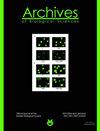Molecular characterization of potentially virulent multidrug-resistant Enterococcus faecalis isolated from acquired urinary tract infections in Egyptian patients
IF 0.8
4区 生物学
Q4 BIOLOGY
引用次数: 0
Abstract
In this study, 154 urine samples were collected from urinary tract infections (UTIs) of hospitalized patients, with 43 (28%) positive for the presence of Enterococcus faecalis without detection of Enterococcus faecium. Based on the demographic data associated with UTI patients, the prevalence of E. faecalis among females was higher than among males in the age group ?41 years; cases from rural areas showed higher infection than from urban localities. Patients not treated with antibiotics were 2.8-fold more likely to be infected with E. faecalis than patients who received antibiotics. At the molecular level, the genes encoding the virulence determinants in E. faecalis, including cytolysins (cylA, cylB and cylM), gelatinase (gelE), E. faecalis antigen A (efaA), extracellular surface protein (esp), aggregation substance (asa) and collagen binding adhesion (ace) were determined using SYBR green real-time PCR. Antibiotic susceptibility testing showed that almost all strains were multidrug-resistant, with an average multiple antibiotic resistance (MAR) index of 0.55. The colorimetric microtiter plate assay showed that 56% of the strains were biofilm producers. A significant correlation was observed between strong biofilm formation and the presence of cylB and cylM genes. Multidrug-resistant E. faecalis and its virulence potential and biofilm formation ability pose a risk to UTI patients.从埃及患者获得性尿路感染中分离的潜在毒性多重耐药粪肠球菌的分子特征
本研究收集了154例尿路感染住院患者的尿液样本,其中43例(28%)粪肠球菌阳性,未检出粪肠球菌。根据与尿路感染患者相关的人口统计数据,在41岁年龄组中,女性的粪肠球菌患病率高于男性;农村地区的感染率高于城市地区。未接受抗生素治疗的患者感染粪肠杆菌的可能性是接受抗生素治疗的患者的2.8倍。在分子水平上,采用SYBR绿色实时荧光定量PCR技术测定了粪肠杆菌毒力决定因子的编码基因,包括细胞溶素(cylA、cylB和cylM)、明胶酶(gelE)、粪肠杆菌抗原A (efaA)、细胞外表面蛋白(esp)、聚集物质(asa)和胶原结合粘附(ace)。药敏试验结果显示,几乎所有菌株均具有多重耐药,平均多重耐药指数为0.55。比色微滴板试验表明,56%的菌株是生物膜生产者。在强生物膜形成与cylB和cylM基因的存在之间观察到显著的相关性。多药耐药粪肠球菌及其毒力潜力和生物膜形成能力对尿路感染患者构成风险。
本文章由计算机程序翻译,如有差异,请以英文原文为准。
求助全文
约1分钟内获得全文
求助全文
来源期刊
CiteScore
1.40
自引率
0.00%
发文量
25
审稿时长
3-8 weeks
期刊介绍:
The Archives of Biological Sciences is a multidisciplinary journal that covers original research in a wide range of subjects in life science, including biology, ecology, human biology and biomedical research.
The Archives of Biological Sciences features articles in genetics, botany and zoology (including higher and lower terrestrial and aquatic plants and animals, prokaryote biology, algology, mycology, entomology, etc.); biological systematics; evolution; biochemistry, molecular and cell biology, including all aspects of normal cell functioning, from embryonic to differentiated tissues and in different pathological states; physiology, including chronobiology, thermal biology, cryobiology; radiobiology; neurobiology; immunology, including human immunology; human biology, including the biological basis of specific human pathologies and disease management.

 求助内容:
求助内容: 应助结果提醒方式:
应助结果提醒方式:


